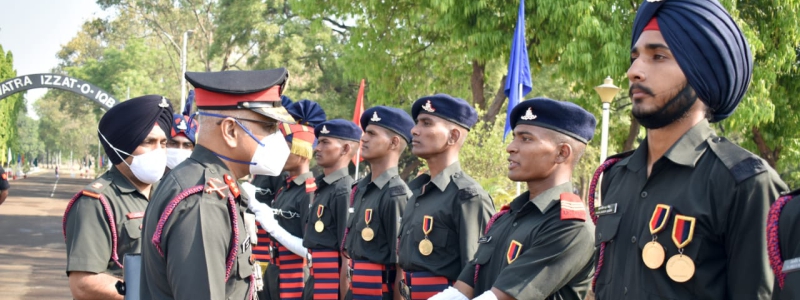THE REGIMENT OF ARTILLERY AND PASSING OUT PARADE
Reading this would for sure give you an idea as to what is the Indian Regiment of Artillery. Along with the knowledge of Artillery Regiment you would also get to know about the Passing Out Parade (POP) of recruits.
At first let me talk about the Indian regiment of artillery.
The Regiment of Artillery is a functional arm of the Indian Army, a replacement to the Royal Indian Artillery (RIA) of British Indian Army, which itself follows its starting points to the arrangement of Bombay Artillery in 1827.
Today it is the second-biggest arm of the Indian Army, and with its weapons, mortars, rocket launchers, automated airborne vehicles, reconnaissance frameworks, rockets and gunnery capability, it establishes right around one-6th of its all out strength.
Talking about the regimental crest
Table of Contents
The peak of the Regiment of Artillery is to a great extent a tradition of the Royal Artillery. Their peak portrayed a weapon with a crown above it, isolated by the world Ubique (Latin for all over). Underneath the firearm was decorated the adage; Quo Fas Et Gloria Ducant (where right and magnificence lead). In the Royal Indian Artillery, the crown was supplanted by star – addressing the Star of India and on second thought of Ubique, the peak conveyed the world
India to recognize the Royal Indian Artillery from the Royal Artillery. The maxim beneath was additionally changed to Izzat-o-Iqbal. After autonomy, the word India was dropped from the regimental peak and supplanted with Sarvatra.

MOTTO
The proverb of the Regiment of Artillery is Sarvatra Izzat-o-Iqbal (Everywhere with Honor and Glory), what could be compared to the Royal Artillery saying Ubique Quo Fas Et Gloria Ducunt (Everywhere that Right and Glory Lead). The Hindustani proverb praises the memory of the Hindu and Muslim heavy weapons specialists who battled during the Indian Rebellion of 1857
REGIMENTAL FLAG
A particular red and naval force blue foundation the authority shades of the Artillery banner structures an optimal setting for the brilliant firearm (the Gunner peak) which shapes the highlight of the banner. Heavy weapons specialist legends had it, that the red and blue addresses the glimmer and the smoke of the firearm, however this isn’t exactly evident. Red has been customarily normal to all battle arms – Infantry, Armor and Artillery. The blue in the Artillery banner was taken from the lace of the ‘Star of India’ which had been consolidated into the Artillery peak. The first tone was light blue, yet since a comparative shade was taken on by the Crops of Signals, it was changed to naval force blue to keep away from disarray.
While the Artillery Regiments convey naval force blue and burgundy red President’s Banners, the weapons are viewed as the regimental tones and are concurred similar commendations as the Standards, Guidons and Colors of the Cavalry and Infantry and the Banners of the Light Infantry and Services and Corps.
RAISING DAY
5 (Bombay) Mountain Battery, the main unit of the Indian Regiment of Artillery was raised on 28 September 1827 as the eighth Company of the Golandaz force, Bombay Foot Artillery. This likewise denoted the raising of the main local ordnance unit and is commended as the day of raising of the Indian Regiment of Artillery.
UNITS
An Artillery Regiment is instructed by an official of the position of a Colonel. Notwithstanding the settle battery, the regiment has three batteries (a part of firearms), each told by officials of the position of Major or Captain (called Battery Commanders).[26] The regiments can be Light Regiments, Medium Regiments, Field Regiments, Missile Regiments, Rocket Regiments and SATA (Surveillance and Target Acquisition) Regiments. There are two Airborne Artillery
Regiments – 9 (Parachute) Field Regiment and 17 (Parachute) Field Regiment.
Full rundown of present ordnance regiments can be gotten to at – List of big guns regiments of Indian Army.
Three to four regiments are gathered to frame a Brigade – which are important for Infantry or Armored Divisions. Autonomous Brigades are under Corps or Commands. Since the 1990s, three Artillery Divisions have been raised –
- 40 Artillery Division – Ambala, Haryana, under Western Command
- 41 Artillery Division (Agnibaaz Division) – Pune, Maharashtra, under Southern Command
- 42 Artillery Division – Alwar, Rajasthan, under Southwestern Command
After knowing all about the regiment of artillery, now know about the POP Passing out parade . Passing Out Parade is praised as a transitioning function for the new cadets. Generally cadets’ folks, or family members, pip in the positions on the cadets’ shoulders after which they formally become authorized officials in the Indian Army.no doubt this ceremony is one of the most memorable of all the events in a person’s life. This day marks your start of journey as an officer, you being a part of the armed forces is all in
For more blogs and details subscribe to blog.majorkalshiclasses.com










